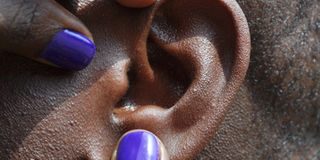Why you may get infections in the ear

Cotton swabs are commonly used to remove wax from the ear. However, doctors say they can cause damage and lead to infections. Photo by Rachel Mabala
An ear infection can be caused by a bacteria, virus or fungi in the eardrum or middle ear. Trauma or a tumour can also lead to infections.
Dr Ricky Byaruhanga, an ear specialist at Kampala Ear, Nose and Throat Clinic, in Kamwokya, says children and elderly people are more prone to ear infections compared to people in other age groups because of their weak immune systems.
People who suffer from recurrent upper respiratory tract infections also have a high risk of developing ear infections as bacteria from the mouth or nose can easily get into the ear.
“At the back of the nose, there is the Eustachian tube, which connects to the ears. It is responsible for balancing pressure and making it possible for a person to hear. Therefore, if a person has an ear infection, it can cause difficulty in hearing,” says Dr Byaruhanga.
Untreated infections
Dr Byaruhanga says untreated ear infections can affect a person’s hearing ability, including causing deafness, brain damage and meningitis.
Treatment
Paediatricians and general doctors can identify and treat cases of ear infections. However, if the condition does not improve, it is important to visit an ear, nose and throat specialist.
An infection can be detected by studying the patient’s history (signs and symptoms) and through an ear examination using an auto scope or a source of light. “When there is need for further investigation to establish the extent of the infection and a management plan, an X-ray or a CT scan may be crucial,” says Dr Byaruhanga.
Minor infections can be treated using anti-bacterial drugs, but when it becomes severe, especially when there is pus discharge, a person may require surgery to repair the perforated eardrum.
“People with infections should keep the ear dry at all times. If a person is going to bathe, they need to insert a piece of cotton roll in the outer ear to keep water away,” says Dr Byaruhanga.
He adds: “We also discourage people with ear infections from swimming until their condition has been treated.”
People are also discouraged from using cotton swabs to remove wax, as this could cause trauma, and therefore lead to infections.
Dr Byaruhanga says many people wrongly believe wax is dirt, and so they forcefully try to remove it. “Wax is a useful secretion that prevents dust from entering the eardrum and has an antiseptic effect that kills bad bacteria,” explains Dr Byaruhanga.
In few instances, he says some people may produce a lot of wax, which blocks their hearing. In such cases, he says a person needs to visit a specialist who will professionally clean their ear.
COMMON SIGNS
A person with an infected ear usually has the following symptoms:
•Pain in the affected ear.
•Difficulty in hearing, which may subsequently lead to deafness.
•Pus discharge.
•Fever.
•Nausea
•Feeling of fullness in the ear
•Diarrhoea
•A person may hear strange sounds in the affected ear.




